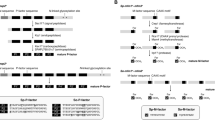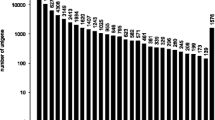Summary
During conjugative transfer of sex pheromone plasmids ofEnterococcus faecalis a so-called surface exclusion protein reduces the frequency with which these plasmids are transferred to cells already possessing the same plasmid. We report here the DNA sequence of a 3 .8 kb fragment of the sex pheromone plasmid pAD1 containing the structural genesea1 for surface exclusion protein and a small open reading frame (ORF) upstream ofsea1. Surface exclusion protein Seal was found to be highly homologous to the surface exclusion protein Sec10 encoded by the sex pheromone plasmid pCF10. Hybridization studies with DNA probes derived from the structural gene seal demonstrated that, with the exception of pAM373, all known sex pheromone plasmids carry a homologous gene. These studies also indicated that the genetic organization is similar in these plasmids, with the structural gene for surface exclusion protein being located 5′ to that for aggregation substance.
Similar content being viewed by others
References
Clewell DB, Weaver KE (1989) Sex pheromones and plasmid transfer inEnterococcus faecalis. Plasmid 21:175–184
Clewell DB, Pontius LT, An FY, Ike Y, Suzuki A, Nakayama J (1990) Nucleotide sequence of the sex pheromone inhibitor (iAD1) determinant ofEnterococcus faecalis conjugative plasmid pAD1. Plasmid 24:156–161
Dunny GM (1990) Genetic functions and cell-cell interactions in the pheromone-inducible plasmid transfer system ofEnterococcus faecalis. Mol Microbiol 4:689–696
Dunny GM, Brown BL, Clewell DB (1978) Induced cell aggregation and mating inStreptococcus faecalis: Evidence for a bacterial sex pheromone. Proc Natl Acad Sci USA 75:3479–3483
Dunny GM, Craig RA, Carron RL, Clewell DB (1979) Plasmid transfer inStreptococcus faecalis: Production of multiple sex pheromones by recipients. Plasmid 2:454–465
Dunny GM, Zimmerman DL, Tortorello ML (1985) Induction of surface exclusion (entry exclusion) byStreptococcus faecalis sex pheromones: Use of monoclonal antibodies to identify an inducible surface antigen involved in the exclusion process. Proc Natl Acad Sci USA 82:8582–8586
Ehrenfeld EE, Clewell DB (1987) Transfer functions of theStreptococcus faecalis plasmid pAD1: Organization of plasmid DNA encoding response to sex pheromone. J Bacteriol 169:3473–3481
Fischetti VA, Pancholi V, Schneewind O (1990) Conservation of a hexapeptide sequence in the anchor region of surface proteins from Gram-positive cocci. Mol Microbiol 4:1603–1605
Galli D, Wirth R (1991) Comparative analysis ofEnterococcus faecalis sex pheromone plasmids identifies a single homologous DNA region which codes for aggregation substance. J Bacteriol 173:3029–3033
Galli D, Wirth R, Wanner G (1989) Identification of aggregation substances ofEnterococcus faecalis after induction by sex pheromones. Arch Microbiol 151:486–490
Galli D, Lottspeich F, Wirth R (1990) Sequence analysis ofEnterococcus faecalis aggregation substance encoded by the sex pheromone plasmid pAD1. Mol Microbiol 4:895–904
Galli D, Friesenegger A, Wirth R (1992) Transcriptional control of sex pheromone inducible genes on plasmid pAD1 ofEnterococcus faecalis and sequence analysis of a third structural gene for (pPD1-encoded) aggregation substance. Mol Microbiol (in press)
Gawron-Burke C, Clewell DB (1984) Regeneration of insertionally inactivated streptococcal DNA fragments after excision of transposon Tn916 inEscherichia coli: Strategy for targeting and cloning of genes from Gram-positive bacteria. J Bacteriol 159:214–221
Henikoff S (1984) Unidirectional digestion with exonuclease III creates targeted breakpoints for DNA sequencing. Gene 28:351–359
Kao S-M, Olmsted SB, Viksnins AS, Gallo JC, Dunny GM (1991) Molecular and genetic analysis of a region of plasmid pCF10 containing positive control genes and structural genes encoding surface proteins involved in pheromone-inducible conjugation inEnterococcus faecalis. J Bacteriol 173:7650–7664
Maniatis T, Fritsch EF, Sambrook J (1982) Molecular cloning — A laboratory manual. Cold Spring Harbor Laboratory Press, Cold Spring Harbor, New York
Minkley EG, Willetts NS (1984) Overproduction, purification, and characterization of the F traT protein. Mol Gen Genet 196:225–235
Nakayama J, Nagasawa H, Isogai D, Clewell DB, Suzuki A (1990) Amino acid sequence of pheromone inducible surface protein inEnterococcus faecalis, that is encoded on the conjugative plasmid pPD1. FEBS Lett 267:81–84
Sanger F, Nicklen S, Coulson AR (1977) DNA sequencing with chain-terminating inhibitors. Proc Natl Acad Sci USA 74:5463–5467
Sukupolvi S, O'Connor CD (1990) TraT lipoprotein, a plasmidspecified mediator of interactions between Gram-negative bacteria and their environment. Microbiol Rev 54:331–341
Wanner G, Formanek H, Galli D, Wirth R (1989) Localization of aggregation substances ofEnterococcus faecalis after induction by sex pheromones. Arch Microbiol 151:491–497
Weaver KE, Clewell DB (1988) Regulation of the pAD1 sex pheromone response inEnterococcus faecalis: Construction and charaterization oflacZ transcriptional fusions in a key control region of the plasmid. J Bacteriol 170:4343–4352
Wirth R, Olmsted S, Galli D, Dunny G (1991) Comparative analysis of cADI- and cFCIO-induced aggregation substances ofEnterococcus faecalis. In: Dunny GM, Cleary PP, McKay LL (eds) Genetics and molecular biology of Streptococci, Lactococci, and Enterococci. American Society for Microbiology, Washington DC, pp 34–38
Wirth R, Friesenegger A, Horaud T (1992) Identification of new sex pheromone plasmids inEnterococcus faecalis. Mol Gen Genet, : -
Yagi Y, Kessler RE, Shaw JH, Lopatin DE, An F, Clewell DB (1983) Plasmid content ofStreptococcus faecalis strain 39-5 and identification of a pheromone (cPDI)-induced surface antigen. J Gen Microbiol 129:1207–1215
Author information
Authors and Affiliations
Additional information
Communicated by W. Goebel
Rights and permissions
About this article
Cite this article
Weidlich, G., Wirth, R. & Galli, D. Sex pheromone plasmid pAD1-encoded surface exclusion protein ofEnterococcus faecalis . Molec. Gen. Genet. 233, 161–168 (1992). https://doi.org/10.1007/BF00587575
Received:
Issue Date:
DOI: https://doi.org/10.1007/BF00587575




